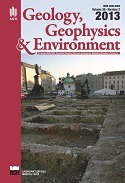The historical layers of the Lower Silesia towns - the investigations based on historical cartography
DOI:
https://doi.org/10.7494/geol.2013.39.2.81Keywords:
history of urbanism, cartography, cities development, history of cartographyAbstract
Studies on the historical layers of historical towns belong to the most important stages of Atlas historyczny miast polskich' volumes' creation.
Lower Silesian towns are investigated mainly on a basis of:
- written sources, which reference to the real space is often doubtful;
- archeological explorations, which results should be confronted with source studies;
- metrological studies, claiming the original medieval concepts according to their geometrical modularity, although those studies are often loaded with big doses of idealism;
- studies on historical cartography, which were performed however usually a few hundred years after the town's foundation; in this case the basic method is relating newer plan to an earlier situation called retrogression.
The last method could regard one of the most mutable, but most important element of a city's historical structure, which is the river. Two examples of this kind of analysis, referring to two of Lower Silesian different size cities of Wrocław and Milicz can be mentioned in this case. Changes of river system in these cities drastically influenced the shaping of cities and their environment. Much more controversial is an issue of reconstruction based on the oldest 18th century cartography of the road system, which was shaping settlements network around Wrocław. The method of using historical cartography as a source of knowledge about a city's changes is giving the best results in a case of wide modern fortifications' analysis, though it is often only confirmed by archeological research.
Downloads
References
Bimler K., 1940-1942. Die Schlesischen massiven Wehrbauten. Kommission Heydebrand - Verlag, Breslau.
Czechowicz B., 2004. Historia kartografii Śląska XIII-XIX wieku. Wrocławska Fundacja Studentów Historii Sztuki, Wrocław.
Eysymontt R., 1998a. Architektura i rozwój przestrzenny w XIX i na początku XX wieku, [in:] Dąbrowski S. (red.), Legnica. Zarys monografii miasta, DTSK Silesia, Wrocław, 320-352.
Eysymontt R., 1998b. Urbanistyka i architektura miasta w okresie baroku, [in:] Dąbrowski S. (red.), Legnica. Zarys monografii miasta, DTSK Silesia, Wrocław, 214-227.
Eysymontt R., 2000. Barwne projekty z XVIII i początku XIX wieku w archiwum w Legnicy. Architectus, 1, 69-80.
Eysymontt R., 2002a. Rozwój przestrzenny, architektura, sztuka, [in:] Kościk E. (red.), Wołów. Zarys monografii miasta, Silesia, Wrocław - Wołów, 154-198.
Eysymontt R., 2002b, Burgum milickie - przemiana w małe miasto, [in:] Busko C. (red.), Civitas et villa. Miasto i wieś w średniowiecznej Europie Środkowej, Instytut Archeologii i Etnologii Polskiej Akademii Nauk, Wrocław, 73-83.
Eysymontt R., 2004. Architektura i sztuka, [in:] Matwijowski K. (red.), Oława. Zarys monografii miasta, Silesia, Wrocław, 199-224.
Eysymontt R., 2008. Dzieje Świdnicy w kartografii. Rocznik Świdnicki, 35, 5-15.
Eysymontt R., 2009. Kod genetyczny miasta. Średniowieczne miasta lokacyjne Dolnego Śląska na tle urbanistyki europejskiej. Via Nova, Wrocław.
Eysymontt J. & Eysymontt R., 2001. Świebodzice, rozwój przestrzenny, architektura - sztuka, [in:] Matwijowski K. (red.), Świebodzice. Zarys monografii miasta, Silesia, Wrocław - Świebodzice, 188-189.
Hanke M. & Degner H., 1935. Geschichte der amtlichen Kartographie Brandenburg Preussens bis zum Ausgang der Friderizianischen Zeit. Stuttgart.
Katalog der Ausstellung des XIII. Deutschen Geographentages zu Breslau. 1901. Genossenschafts-Buchdruckerei, Breslau.
Kuhlmey J.F., 1825. Plan der Stadt Liegnitz nebst ihren Yorstddten und nachsten Umgebungen Liegnitz bei, Aufgenommen u. gezeichnet vom K. Radierungs Conducteur Stumpe im Jahre 1825. Staatsbibliothek zu Berlin, sign. x 28 808.
Kuhlmey J.F., 1826. Plan der Stadt Liegnitz nebst ihren Hausnummern und offentliche Gebduden Aufgenommen und gezeichnet vom K. Regier Conducteur Stumpe, Liegnitz. Staatsbibliothek zu Berlin, sign. x 28 812.
Lindner K. & Zogner L., 1987. Zwischen Oder und Riesengebirge. Schlesischen Karten aus funf Jahrhunderten. Ausstellung der Staatsbibliothek Preussischer Kulturbesitz, Berlin.
Lindner K., 1985. Wredes "Krieges Carte von Schlesien" - die erste preussische Landesaufnahme Schlesiens. [in:] von Scharfe W. & Jager E. (eds), Kartographiehistorisches Colloąuium Luneburg '84, 15.-17. Marz 1984, Vortrage, Berlin, 39-53.
Maschke T., 1928. Die topographischen Karten (Landesaufnahmen) Schlesiens aus der Zeit Friedrich des Grossen. Zeitschrift des Vereins fur Geschichte Schlesiens, 62, Breslau, 331-335.
Młynarska-Kaletynowa M. & Eysymontt R. (red.), 2001. Atlas historyczny miast polskich. Tom 4: Śląsk. Zeszyt 1: Wrocław. Via Nova, Wrocław.
Młynarska-Kaletynowa M., Eysymontt R. & Goliński M. (red.), 2009. Atlas historyczny miast polskich. Tom 4: Śląsk. Zeszyt 9: Legnica. Wydawnictwo Uniwersytetu Wrocławskiego, Wrocław.
Plan of Świdnica with fortifications. 1762. Staatsbibliothek zu Berlin-Preussischer Kulturbesitz, Berlin, sign. Kart. x 33 650-B1. 3.
Schlenger H., 1938. Des grossen Konigs Krieskarte. Schlesische Monatshefte, 17, 18.
Schlenger H., 1930. Form landlicher Siedlungen in Schlesien. Beitrdge zur Morphologie der schlesischen Kulturlandschaft. Verlag von M. & H. Marcus, Breslau.
Situations Plan Der statd Waldenburg nebst umherliehgenden Grenzen wie Solche Anno 1736 und 1737 von Tit. Herrn Friedrich Gottlieg Schulz Kayserlichen Ingenieur Lieutenant und Geometra vermessen und aufgenomen. Copiert Ao 1777. Herder Instytute in Marburg, sign. 03348.
Szulc H., 1963. Osiedla podwrocławskie na początku XIX wieku, [in:] Monografie Śląskie Ossolineum, 5, Zakład Narodowy im. Ossolińskich, Wrocław.
Von Gross?, Bauinspector, 1777, Situations Plan von dem Ringe der Stadt Neumarkts. National Archive in Wrocław, sign. Kartografia Rejencji Wrocławskiej IV/227.
Wernher F.B., 1756. Topographia oder Prodromus Delineati Principatus Lignicensis Bregensis, et Volaviensis, 1744-1768 [...]. Yolumen IV: Das ist Furstentum Liegnitz: Liegnitz, Brieg Wohlau Trachenberg. Furstentum Brieg. von F. B. Wernhero, p. 131, sign. XVII HA Rep. 135 nr 526/4.
Wytyczak R., 1998. Śląsk w dawnej kartografii. Obraz Śląska na mapach XVI-XVIII wieku w zbiorach Zakładu Narodowego im. Ossolińskich we Wrocławiu. Towarzystwo Przyjaciół Ossolineum, Wrocław.
Zimmermann F.A., 1783-1795. Beytrage zur Beschreibung von Schlesien. Bd. 1-12.
Downloads
Published
Issue
Section
License
Authors have full copyright and property rights to their work. Their copyrights to store the work, duplicate it in printing (as well as in the form of a digital CD recording), to make it available in the digital form, on the Internet and putting into circulation multiplied copies of the work worldwide are unlimited.
The content of the journal is freely available according to the Creative Commons License Attribution 4.0 International (CC BY 4.0)










